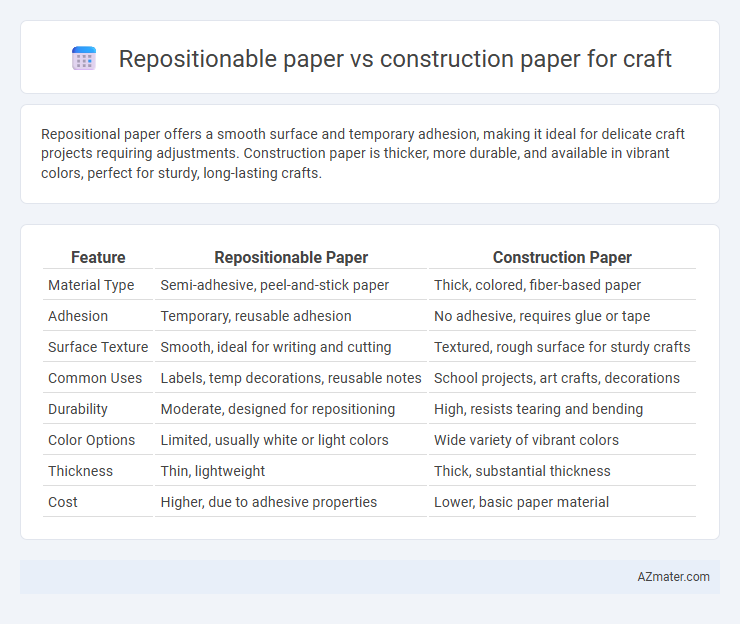Repositional paper offers a smooth surface and temporary adhesion, making it ideal for delicate craft projects requiring adjustments. Construction paper is thicker, more durable, and available in vibrant colors, perfect for sturdy, long-lasting crafts.
Table of Comparison
| Feature | Repositionable Paper | Construction Paper |
|---|---|---|
| Material Type | Semi-adhesive, peel-and-stick paper | Thick, colored, fiber-based paper |
| Adhesion | Temporary, reusable adhesion | No adhesive, requires glue or tape |
| Surface Texture | Smooth, ideal for writing and cutting | Textured, rough surface for sturdy crafts |
| Common Uses | Labels, temp decorations, reusable notes | School projects, art crafts, decorations |
| Durability | Moderate, designed for repositioning | High, resists tearing and bending |
| Color Options | Limited, usually white or light colors | Wide variety of vibrant colors |
| Thickness | Thin, lightweight | Thick, substantial thickness |
| Cost | Higher, due to adhesive properties | Lower, basic paper material |
Introduction: Repositional Paper vs Construction Paper
Repositional paper offers a smooth surface with a temporary adhesive backing, ideal for crafts requiring adjustable placement without residue, while construction paper provides a sturdy, textured base perfect for cutting, folding, and long-lasting projects. Repositional paper's repositionable quality enhances precision and reduces waste, contrasting with the durability and vibrant colors typical of construction paper. Both materials serve distinct craft functions, with repositional paper excelling in flexibility and construction paper in structural support.
Material Composition and Texture Differences
Repositional paper is typically made from lightweight, coated paper designed for temporary adhesion and smooth repositioning, often using a silicone or adhesive backing that allows easy removal without residue. Construction paper consists of thicker, rough-textured cellulose fibers, giving it durability and a coarse surface ideal for various art and craft projects requiring sturdiness. The smoother texture of repositional paper contrasts with the fibrous, matte finish of construction paper, influencing their suitability for specific crafting techniques and adhesive applications.
Adhesion and Reusability Features
Repositional paper offers moderate adhesion, allowing craft elements to stick securely yet be easily lifted and repositioned multiple times without residue, making it ideal for temporary layouts and iterative designs. Construction paper provides strong, permanent adhesion, suitable for projects requiring lasting bonds but limits repositioning due to its porous texture and rough surface. The reusability of repositional paper enhances flexibility in crafting, while construction paper's adhesive durability supports more robust, enduring creations.
Color Variety and Vibrancy Comparison
Repositional paper offers limited color variety but excels in vibrancy, making it ideal for vibrant, temporary craft projects. Construction paper features a broader color palette with more muted tones, providing versatility for detailed and permanent crafts. Artisans seeking vivid hues prioritize repositional paper, while those needing diverse color options favor construction paper.
Suitability for Different Craft Projects
Repositional paper offers excellent suitability for temporary placements, making it ideal for layered craft projects, stencils, and scrapbooking where adjustments are needed without damage. Construction paper is better suited for vibrant, sturdy base projects such as card making, collages, or children's crafts due to its thickness and variety of colors. Craft enthusiasts often choose repositional paper for precision tasks and construction paper for durability and bold color presence.
Durability and Resistance to Wear
Repositional paper offers moderate durability with a semi-adhesive quality that allows easy repositioning without tearing, making it ideal for temporary placements and light crafts. Construction paper provides superior resistance to wear due to its thicker, fibrous texture and sturdier composition, ensuring long-lasting projects that endure handling and glue applications. While repositional paper favors flexibility, construction paper excels in durability for robust, long-term craft creations.
Ease of Cutting and Shaping
Repositional paper offers superior ease of cutting and shaping due to its flexible, adhesive-backed surface that allows for temporary placement and repositioning without tearing. Construction paper tends to be thicker and more fibrous, which can make precise cutting and detailed shaping more challenging, especially for intricate craft projects. Crafters seeking clean edges and adaptability often prefer repositional paper for its smooth texture and versatility in repeated adjustments.
Cost Effectiveness and Availability
Repositional paper offers cost-effective advantages due to its reusable adhesive properties, reducing the need for multiple sheets in craft projects, and it is widely available in office supply and art stores. Construction paper, while typically less expensive per sheet, often requires more quantity due to its single-use nature, and is easily accessible in bulk at craft and school supply retailers. Both materials provide budget-friendly options, but repositional paper's longevity enhances overall cost savings for extended or detailed crafting tasks.
Environmental Impact and Recyclability
Repositional paper typically contains synthetic adhesives, which can complicate recyclability and increase environmental impact due to non-biodegradable components. Construction paper is generally more eco-friendly, made from cellulose fibers that are biodegradable and easier to recycle, reducing landfill waste. Choosing construction paper for crafts supports sustainable practices by minimizing pollutant release and facilitating efficient recycling processes.
Choosing the Right Paper for Your Craft Needs
Choosing the right paper for your craft projects depends on the specific requirements of adhesion and texture. Repositional paper excels in projects needing temporary sticking and easy repositioning without residue, making it ideal for scrapbooking or stencils. Construction paper offers durability and vibrant colors, perfect for cutting, folding, and creating long-lasting craft items like cards and decorations.

Infographic: Repositional paper vs Construction paper for Craft
 azmater.com
azmater.com